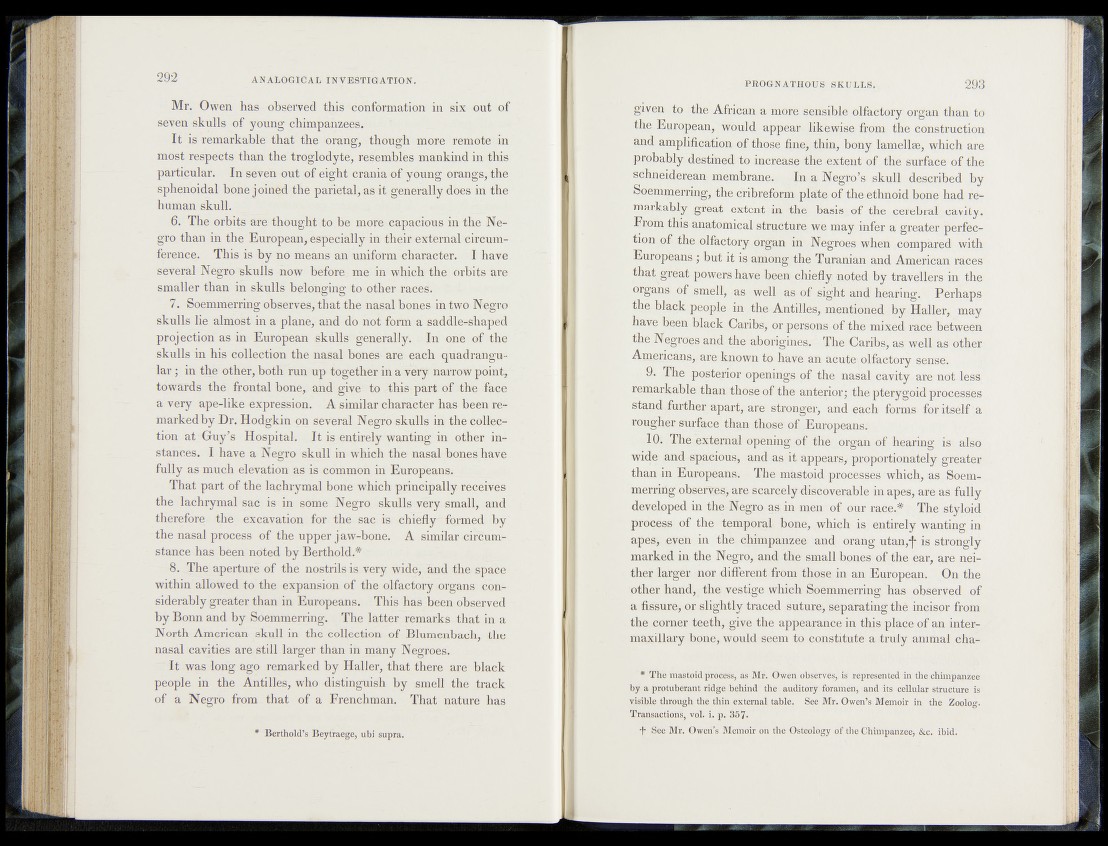
Mr. Owen has observed this conformation in six out of
seven skulls of young chimpanzees.
It is remarkable that the orang, though more remote in
most respects than the troglodyte, resembles mankind in this
particular. In seven out of eight crania of young orangs, the
sphenoidal bone joined the parietal, as it generally does in the
human skull.
6. The orbits are thought to be more capacious in the Negro
than in the European, especially in their external"circumference.
This is by no means an uniform character. I have
several Negro Tskulls now before^ me in which the orbits are
smaller than in skulls belonging to other races.
7. Soemmerring observes, that the nasal bones in two Negro
skulls lie almost in a plane, and do hot form a saddle-shaped
projection as in European skulls generally. • In one of the
skulls in his collection the nasal bones are each quadrangular
; in the other, both run up together in a very narrow point,
towards thé frontal bone, and give to This-part ofThe .fane
a very ape-like expression. A similar character has been remarked
by Dr. Hodgkin on several Negro skulls in the collection
at Guy’s Hospital. It is entirely wanting in other instances.
I have a Negro skull in which the-nasal bones have
fully as much elevation as is common in Europeans.
That part of the lachrymal bone which principally receives
the lachrymal sac is in some Negro skulls very small, and
therefore the excavation for the sac is chiefly" formed by'
the nasal process of the upper jaw-bone. A similar circumstance
has been;noted by Berthold.*
8. .The aperture of the nostrils is very wide, and the space
within allowed to the expansion of the olfactory organs. considerably
greater than in Europeans. Thië has been observed
by Bonn and by Söémmerring. The latter remarks that in a
North American skull in thé collection of Blumenbach, the
nasal cavities are-still,larger than in many; Negroes.
‘ I t was long ago remarked by Haller, that there are black
people in the Antilles, who distinguish by smell the track
of a Negro from that of a Frenchman. That nature has
* Berthold’s Beytraege, ubi supra.
given to the African a more sensible olfactory organ than to
the European," would appear likewise from the construction
and amplification of those fine,-thin, bony lamellee, which are
probably destined to increase the extent of the surface of the
schneiderean membrane. - In a Negro’s skull described by
Soemmerring,. fthe cribreform plate of the ethnoid bone had re*-
markably grfeat extent:in the basis.of the cerebral cavity.
From this anatomical structure wean^y infer a greater perfection
plbthe olfactory organ in Negroes when compared with
Europeans ; but it is among the Turanian and American races
th a tg re a t powershave been chiefly, noted by travellers in the
organs^ of smelly tas>*ryell^’-8^|>pf, sight an'd hearing. Perhaps
thi-black people in^e*Antilles, mentioned^by.Haller,/may
have been black Caribs, or person« qflpfe mixed race between
the,Negroes £nd the aborigines/ The C a rib s^ a /Je ll as other
Americans^re known to have an aeute^olfactory qen'&e'^«
9. The poste/for openings of the, nasal cavity are not Jess'
remarkable than those of the anterior • the pterygoid pyo.cessqs
standTurther apart, are stronger^ and each forms for itself a
rougher surface than thosef, pkyEuropeans.v,,
10:. The external opening of the organ-of hearing is* also
wide,- and-spacious, and as it appears,vprQportionately greater
than in Europeans. The mhStoid^pt©c;es^;es;t which, as Soem-.
merririg obser^S, are scarcely discoverable in apes, are as fully
developed in the-Negro as' in men of o,ugrace.# The styloid
process of the temporal bone, which entirely wanting in
apes, even in the chimpanzee and . ©rang u tan ,f is strongly
marked in the Negro, and the smallhones* of; the ear, are neither
larger nor different from those in an, European. On the
other hand, the vestige which Soemmerring has .observed of
a fissure, or slightly traced suture, separating the incisor from
the corner teeth, give the appearance in- this place of an inter-,
maxillary bone, would seem to constitute a truly animal cha-
* The mastoid process, as Mr. Owen observes;,' i#.reprcsented in the chimpanzee
by a protuberant ridge behind the auditory foramen, and its cellular structure is*
visible through the thin external table. See Mr. Owen’s Memoir in the Zoolbg.
Transactions, vol. i. p. 357*
T See Mr. Owen’s Memoir on the Osteology of the Chimpanzee, &c. ibid.